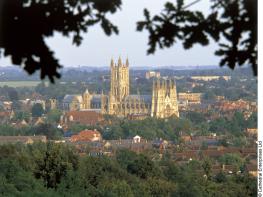Set in acres and acres of landscaped grounds, Eastwell Manor dates back to the Norman conquest…
Wye and the North Downs

8 miles (13kms)
About the walk
As you walk along the North Downs, take a moment or two to think about the land beneath your feet – the chalk was laid down in warm, shallow seas almost 70 million years ago. Today chalk provides an ideal surface for walking – it drains well and doesn't get claggy. However, originally there was a fine mud beneath the sea, made from billions of tiny shells and the remains of small plants – a sort of gloopy, calcium rich soup. The North Downs were formed when movements of the earth's surface forced the Weald of Kent upwards, like a sheet of paper being crumpled. The top of the fold eroded, leaving the chalky spine of the Downs exposed.
The most dramatic feature on this walk is the deep gully of the Devil's Kneading Trough, which was formed at the end of the last ice age. Kent, unlike most of Britain, was never covered by thick ice sheets, however the ground was almost permanently frozen during the winter months, like parts of the Arctic or Russia today. In the spring, when the thaw set in, the meltwater would gouge deep valleys like this into the chalk.
As you stand looking across this deliciously green and varied landscape, it's hard to believe that you are looking at something that is artificial. But open chalk downlands only look the way they do because for thousands of years farmers grazed their animals here. The area around the Devil's Kneading Trough is a precious wildlife reserve and is home to wild flowers such as cowslips, violets, orchids, ox-eye daisies and the wonderfully aromatic wild thyme. Cowslips, so rare today, were once as abundant as buttercups and were strewn beneath the feet of country brides. They used to be known as 'freckled face' because of the orange spots at the base of their petals – spots which Shakespeare thought gave them their delicate scent. In contrast, the fragrance of wild thyme is due to the presence of an oil called thymol, a natural antiseptic. It was traditionally used in the posy carried by monarchs when they presented Maundy money to their subjects. No, it wasn't there for decoration. It was there to give the monarch some protection from the infectious diseases carried by the poor.
Walk directions
From the church, walk down Church Street, turn left at the bottom, then right along Cherry Garden Lane. Keep ahead, crossing over a road and continuing along the path, past a beech hedge.
Keep ahead on reaching the road, past the imposing Withersdane Hall, soon to rejoin the path where the road curves sharp right. There are flat fields to either side but don't worry, this walk's not all so monotonous – just be patient. At the road, cross over and continue ahead, following the track ahead – this can get very muddy. At a crossing of tracks maintain direction, and follow a marker post straight across a field to reach the road.
Turn right and in a few paces take the footpath left at a sign saying 'Welcome to Wye Downs'. Walk up the steps, go through a gate and continue winding your way to the top of the hill, passing the dramatic gorge known as the Devil's Kneading Trough on your right. You get wonderful panoramic views from here. Beyond a gate, turn left through a further gate and follow the North Downs Way ahead and through trees to the road.
Turn right along the road, and then cross the stile on the left, just by the entrance to the Devil's Kneading Trough Restaurant. Walk along the field edge, go right at the marker post and keep to the right of a wood. Soon the path winds through trees to a road. Turn left here and keep ahead. At the second crossroads, climb the stile on the right-hand corner. Walk along the edge of the field, following it right to cross three more stiles and join a road.
Turn left here and walk up to the village green and pond at Hastingleigh. Turn right, past the war memorial, and then take the bridleway on the left. At the corner of the woods, where the main track goes ahead, turn left to walk along the field-edge. Your path now goes ahead, across the middle of a field, over a stile and into woodland. Go straight through the wood and come out on the road.
Continue walking ahead and at the busier road, cross over and maintain direction up the clear track. Walk across the middle of the field to a junction of paths. Go to the right here, along the field-edge track, down to a tarmac lane. Turn left, walk past houses on your right and continue to pass to the right of Little Combe. The tarmac gives way to a track, keep ahead along the field-edge, eventually passing through a wood to reach a gate.
Additional information
Footpaths, wide grassy tracks and field margins, several stiles
Dramatic valleys and rolling downs
Can run free in places; older dogs won't like the climb
OS Explorer 137 Ashford
Car park and roadside parking near Wye church
Opposite Wye church
WALKING IN SAFETY
Read our tips to look after yourself and the environment when following this walk.
Find out more
Also in the area
About the area
Discover Kent
The White Cliffs of Dover are an English icon – the epitome of our island heritage and sense of nationhood. They also mark the point where the Kent Downs AONB, that great arc of chalk downland stretching from the Surrey Hills and sometimes known as ‘the Garden of England’, finally reaches the sea. This is a well-ordered and settled landscape, where chalk and greensand escarpments look down into the wooded Weald to the south.
Many historic parklands, including Knole Park and Sir Winston Churchill’s red-brick former home at Chartwell, are also worth visiting. Attractive settlements such as Charing, site of Archbishop Cranmer’s Tudor palace, and Chilham, with its magnificent half-timbered buildings and 17th-century castle built on a Norman site, can be found on the Pilgrim’s Way, the traditional route for Canterbury-bound pilgrims in the Middle Ages.
In the nature reserves, such as the traditionally coppiced woodlands of Denge Wood and Earley Wood, and the ancient fine chalk woodland of Yockletts Bank high on the North Downs near Ashford, it is still possible to experience the atmosphere of wilderness that must have been felt by the earliest travellers along this ancient ridgeway.
Nearby stays
Restaurants and Pubs
Nearby experiences
Recommended things to do
Why choose Rated Trips?
Your trusted guide to rated places across the UK
The best coverage
Discover more than 15,000 professionally rated places to stay, eat and visit from across the UK and Ireland.
Quality assured
Choose a place to stay safe in the knowledge that it has been expertly assessed by trained assessors.
Plan your next trip
Search by location or the type of place you're visiting to find your next ideal holiday experience.
Travel inspiration
Read our articles, city guides and recommended things to do for inspiration. We're here to help you explore the UK.

















